
The idea that automakers will always include AM/FM radio in their dashboards has always been one of those “givens” in the long-term, storied relationship between radio and automotive.
Let’s review the history of this marriage, now celebrating its 90th anniversary in the States. A car company I’d never heard of – the American Galvin Manufacturing Corporation – first sold a Motorola radio in their vehicle for $130 way back in 1930. That would be the rough equivalent of charging $8,000 for a car radio in a 2022 model.
Fortunately, Plymouth came along with a sedan “wired for Philco Transitone radio with no extra cost” featured in a Ladies’ Home Journal ad in 1931. And since then, car makers have not had the audacity to charge for an AM/FM radio in the dash.
That is, until Elon Musk came along, and resurrected the idea. And it is not a good sign for the future of this once-perfect relationship.
Perfect at least for the radio broadcasting industry. (I will focus on Musk and his Teslas in tomorrows post.)
Because it has always been considered “standard equipment” – like the glove box, rear-view mirror, and turn indicators, inertia has kept automakers dutifully installing those car radios in dashboards.
Until recently, the AM/FM radio only had to co-exist with an 8-track, cassette, CD, or DVD player in the center of the dash. In 2007, Ford’s SYNC system changed all that, and today’s vehicles pretty much all offer connectivity, smartphone pairing, voice control, increasingly bigger screens, and many more entertainment and information options.
And AM/FM radios are still included in what have become bigger feature bundles of in-car media.
Or are they?
If you’ve ever been married, you know a secret to a successful relationship is understanding your partner’s feelings. It is not just about YOU.
So, take a moment and consider it from Ford, Toyota, Subaru, or Volvo’s point of view. The only party generating revenue from those car radios in the dash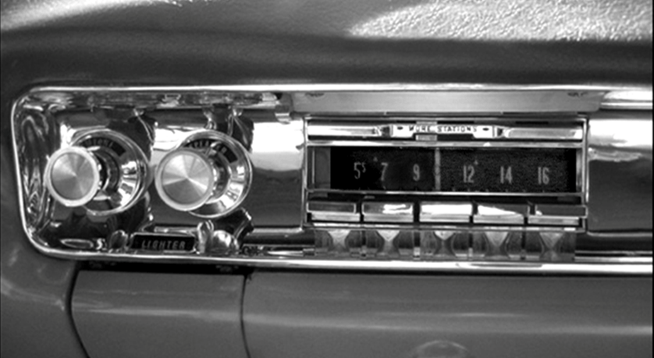 are radio broadcasters. Radio stations and networks have been successfully monetizing them for nearly a century. They are a central part of radio’s mobility, its connection to retail advertisers, and its ability to entertain and inform millions while they motor from Point A to Point B.
are radio broadcasters. Radio stations and networks have been successfully monetizing them for nearly a century. They are a central part of radio’s mobility, its connection to retail advertisers, and its ability to entertain and inform millions while they motor from Point A to Point B.
What do automakers derive from the relationship? In a word, zero, nada, zilch, doodly-squat, nothing.
Despite what you’ve heard, installing radios in cars doesn’t just cost automakers a buck or two. There are engineering, equipment, installation, quality control, and other associated costs. And given the scale of being an auto manufacturer, you take your savings wherever you can find them.
Everyone in radio knows the car is the medium’s #1 listening location – especially as AM/FM radios have disappeared in homes and workplaces in recent years. Radio had to face this reality in March of last year when the lockdowns and stay-at-home orders went into effect. Many consumers discovered they did not have access to a “regular radio” in their homes, apartments, and condos.
And thanks to the Delta variant, WFH, and the “Great Resignation,” in-car listening levels may not return to 2019 levels for some time to come. Or ever.
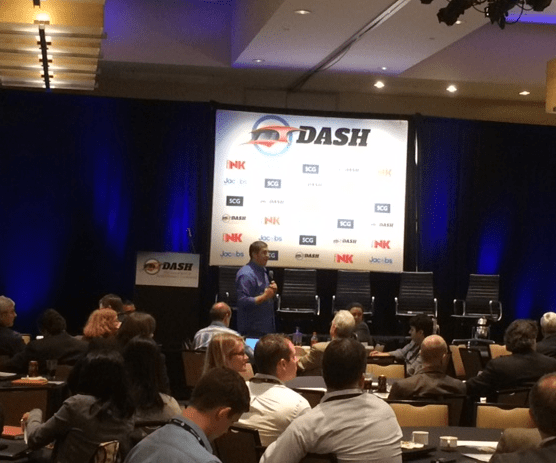
The automakers have done radio a big favor over the years, with little thanks or acknowledgment from the broadcast community. That’s a major reason why Jacobs Media partnered with Radio Ink in 2013-15 to produce three DASH Conferences strategically located in Detroit. These events were successful mashups of radio and auto execs, brought together to share information, stories, knowledge, and experience, as well as to build important connections and explore partnerships.
And it worked. Sort of.
The NAB launched a committee dedicated to shoring up radio’s automotive relationship, experts from that community were brought in, and radio reached out to peers in the car world, via events such as car shows, conferences, and most notably, CES. Jacobs Media was hired for myriad projects as well. Overall, the committee was on a good path.
In the meantime, the dashboard evolution continued with the debuts of Apple CarPlay and Android Auto in 2014. These platforms essentially take over a car’s dashboard by mirroring the apps (at least some of them) from the driver’s smartphone.
When these two systems first hit the scene, we were at CES. Several automakers told us they would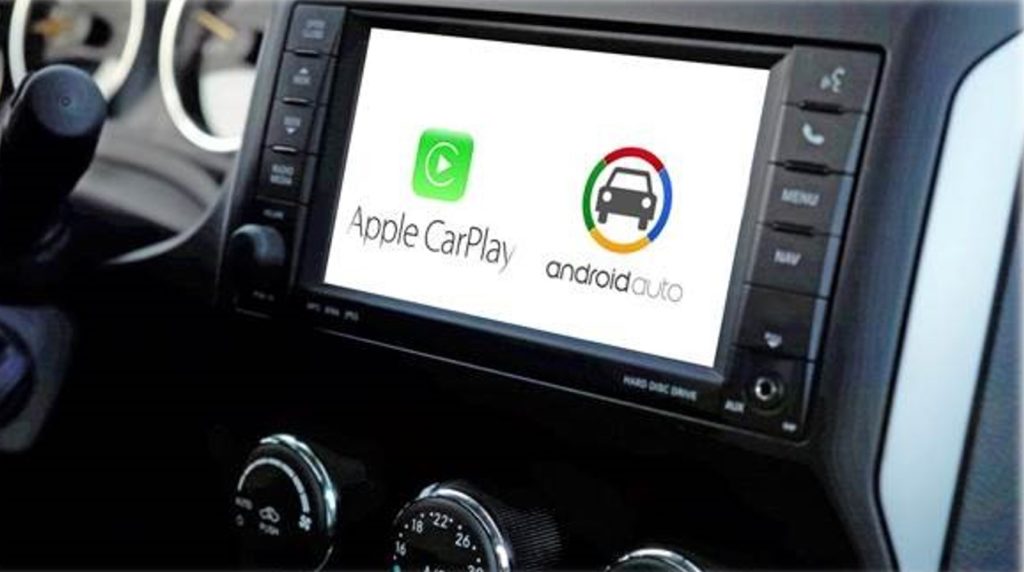 never give into these tech giants by ceding their technology and branding to Apple and Google. The AM/FM disappears, too.
never give into these tech giants by ceding their technology and branding to Apple and Google. The AM/FM disappears, too.
One year later – thanks in large part to consumer demand – most of them caved. Today, most vehicles feature Apple CarPlay and/or Android Auto. And every car manufacturer is on board. jacapps was the first of broadcast radio’s app developers to “crack the code” so individual station apps could be displayed on these systems. That’s the good news. The bad news is that when these systems are in use, the car’s radio tuner is in the background.
And then COVID hit. As we know, the NAB has had a particularly challenging couple of years, between a new building, leadership changes, conference cancellations, and other speed bumps.
While the car companies have also experienced their own set of issues – a remote workforce, chip shortages, supply chain problems, and dealership disruptions – they are forging ahead into an exciting, if somewhat unknown future.
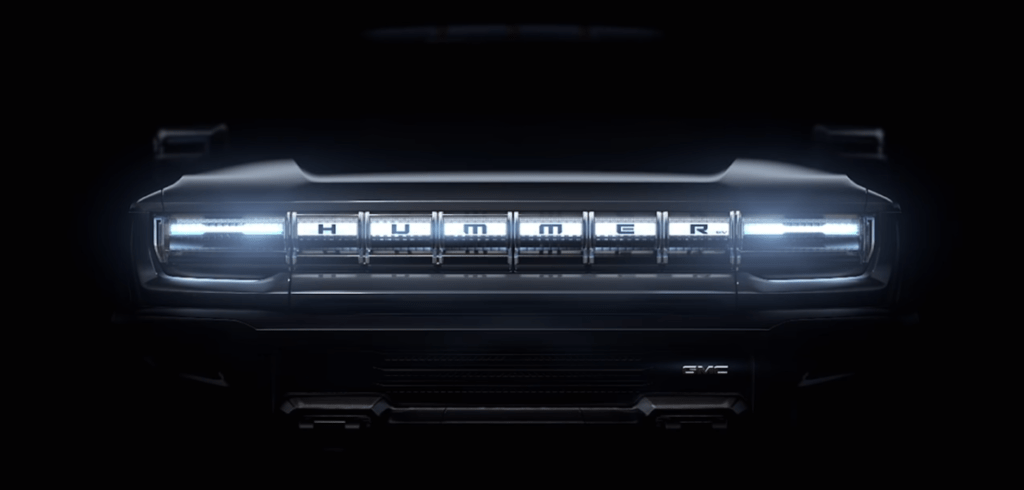 While the march to autonomous vehicles may have slowed down, electrification has become a major initiative involving every manufacturer. From Ford’s F150 trucks and Broncos to GM’s Hummer (left), electric vehicles are trending.
While the march to autonomous vehicles may have slowed down, electrification has become a major initiative involving every manufacturer. From Ford’s F150 trucks and Broncos to GM’s Hummer (left), electric vehicles are trending.
And along the way, dashboard technology – the in-car experience – continues to evolve with each passing year, especially given advances in voice commands, the growing importance of display, and the expansion of Apple and Google’s in-car ecosystems.
In most vehicles, radio is still “there.” It is just harder to find. Think of it like your grocery store, where certain items used to have “end cap” positions at aisles but are now buried with all the other competing products on cluttered store shelves. That’s how radio is now positioned in many new vehicles.
I’ve written before about “pillar-to-pillar” dashboard systems, like the Mercedes Benz Hyperscreen – a 56″ long display that uses Artificial Intelligence to surface the activities and features drivers and passengers access the most, while hiding those they use less frequently, if at all. So, if a new owner of one of these high-end vehicles doesn’t listen to that AM Talk station or that FM “we play anything” outlet for a few days, but accesses Spotify and Howard 100 on SiriusXM, she will see her preferences reflected on the Hyperscreen display. For radio, it could be “out of sight, out of mind.”
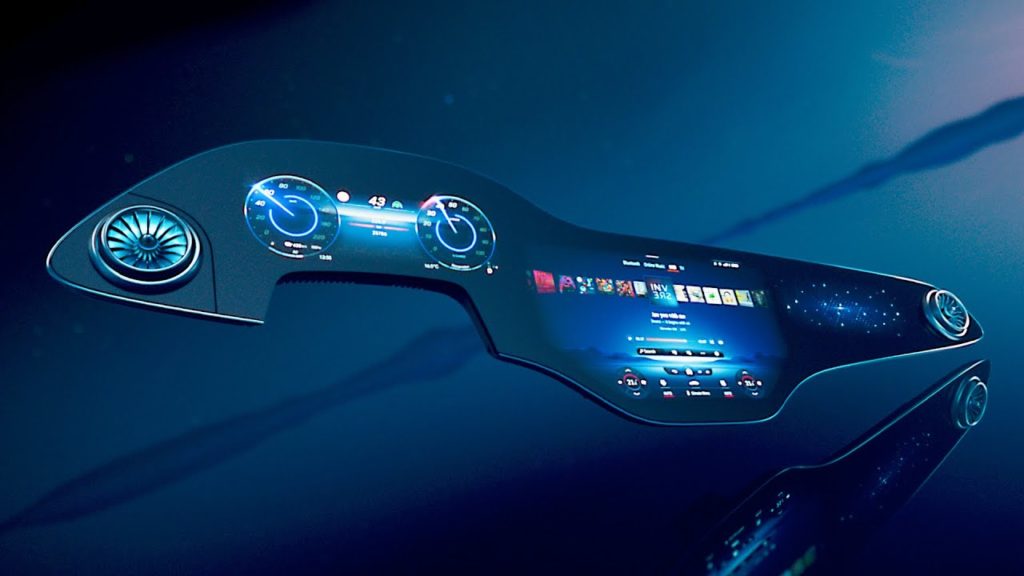
This bigger than life display system isn’t a concept. It’s available NOW on Mercedes’ EQS EV models – one of their electric offerings, priced as an option at around $9,000 (shades of that old Philco radio, right?).
Some of you will remind me that many consumers dislike this technology, often craving the simpler days of knobs, switches, and buttons. And while it’s true J.D. Power says a top complaint about new cars revolves around problems pairing a smartphone – as covered in a “Junk Drawer” blog post last month – those pot holes will disappear as the technology becomes more intuitive.
Remember when your parents’ VCR was hopelessly flashing “12:00?” Now they’re seamlessly watching Squid Games on Netflix, and Facetiming the grandkids. Tech doesn’t just become less expensive. Over time, it becomes easier to afford, navigate, use, and enjoy.
 Tomorrow’s post will take a trip in the “Wayback Machine” to a Convergence Conference in 2013 that took place in Silicon Valley.
Tomorrow’s post will take a trip in the “Wayback Machine” to a Convergence Conference in 2013 that took place in Silicon Valley.
Even back then, the question about whether AM and FM radio would survive in new cars was being asked. It’s now a very germane question as we study the radio/car landscape in 2021.
Tomorrow, I’ll update the state of the car/radio partnership.
Meanwhile, know any good marriage counselors?
You can read the second part of this post – “Radio’s Car Radio Paranoia 2: What If Eric Rhoads Was Right?” – here.
And part 3 – “Addressing My Car Radio Paranoia 3: Let’s Fix It” – here.
- Media And Technology In 2025: Believe It Or Not! - April 18, 2025
- In Radio, You Just Never Know - April 17, 2025
- The Secret To Making A Great Podcast (And Great Radio) - April 16, 2025



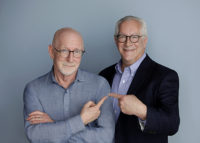
Today’s offering is another example of courage. Yep, courage. Fred you routinely ask yourself and us the tough questions, that will lead to better content, reach and connection for all stakeholders. Far too many broadcast leaders are merely racing to their career’s end in avoidance of the tough stuff. Your candor and counsel continues to offer challenge and clarity that this seasoned broadcaster welcomes daily. Cheers
Much appreciated, Scott. That’s the goal, and sometimes, it hits uncomfortably close to home. It truly pains me to write posts like this, but the signs are all there. Thanks for commenting.
Thank you, Fred. Real Radio Content is Automotive Must Carry!
One can only hope, Clark. Thanks for checking in.
I think voice control might re-level the playing field. Put a sufficiently intelligent, conversational media agent in the car, and “on the dashboard” will lose all meaning, for all players. Pairing the phone could still be a problem (and wow, why is that so freakin’ difficult?) which could be overcome by standard onboard connectivity.
Great post, and I look forward to tomorrow’s follow-up.
Thanks, Brad. Agree about voice. It could end up being a relatively seamless way of accessing radio. It would help if more stations leaned into promoting voice on all platforms.
Regarding phone pairing, I think what may happen is that the car dealer/salesperson is the one who initially sets it up. But when it “unpairs” (as happens), the owner doesn’t know how to restore the connection. And the thick handbook isn’t an incentive to look it up.
I’ve done lots of research among drivers whose phones are paired, but they don’t end up using it for conversations. I’m not sure what’s going on there.
Thanks or engaging on this.
Great article Fred. I’m sure there were doubts many years ago about consumers not having an FM radio in there houses too. I have an old alarm clock radio still plugged in but it’s only to monitor my stations when they’re having problems. When I ask my friends if they have one they almost all say “no”. Of course with station apps and websites listeners still have access, but the days of having a radio in every room are long gone.
Very much so, Craig. Our newest Techsurvey shows that only eight in ten core radio fans have a working radio at home. It logically runs lower than that for people who have less and less to do with thee medium. Thanks for the comment.
More foreboding (and essential) material to consider and process. Great work, Fred.
We can’t say we haven’t been warned about an approaching storm.
And it might not be too long before all automobile features are custom and sold a la car(te). You wanna super-size your audio system? You want the whole dashboard meal or just the sandwich? And do you want the deluxe windshield wipers with that SUV or just the basic ones?
Thank you, Dave. It could end up that way. The manufacturers have never been more focused on costs, spending, and monetization. Appreciate the comment.
“What do automakers derive from the relationship? In a word, zero, nada, zilch, doodly-squat, nothing.”
Cruisin’ and playin’ the radio
With no particular place to go – Chuck Berry
I would say the thousands and thousands of songs written about the love affair with autos and radio would suggest they got a little more than nothing Fred but I understand your point and how important it is to keep those love songs coming.
Which we haven’t.
There is one other reason you didn’t hit on that I think is important and also one of the reason the manufacturers embraced Car Play and Android Auto – they will now sell you a Wi-Fi package for your car.
I have a Buick and for $25 a month, I too can have an “Unlimited Data Plan” for my vehicle. Giving away “free radio” doesn’t help them make money.
“As we celebrate mediocrity all the boys upstairs want to see
How much you’ll pay for what you used to get for free” – Tom Petty
If you have a fading love affair on one side and you have a revenue stream on the other, we know which sides loses out.
We better reignite that love affair ASAP.
Yeah, Mike, that’s the challenge. Radio broadcasters aren’t about to start writing checks to the OEMs. So, as you suggest, we’d better take a different path.
As for CarPlay and Android Auto, that WiFi package is a thing. But the other part of it is that each of the 30-something OEMs had a different dashboard solution – none of which were compatible or intuitive. Apple and Google came along with a better, simpler, and more familiar platform. And once consumers started asking for it, it was game set match.
Imagine a world where consumers demand not to take the radios out of the dashboard. It would be nice. Thanks for the comment.
Fred, you’re a genius-but consumers haven’t made one complaint when AM/FM was removed from my drill charger, my shower speaker or my bedside media player/phone charger. Consumers didn’t complain when the AM/FM kitchen radio was obliterated by the kitchen microwave. When consumers want talk, music, comedy, news -whatever – they migrate to the simplest way to get it. They don’t care the platform, they just want to know it’s there. Broadcast radio has a lot more competition these days and it needs to address them in order to survive. There are still advantage to AM/FM, but -in my opinion -we certainly need to visit it and make it more relevant!!
I’m with you on this, Dave. I think the environment is changing much quicker than many radio people realize.
I once had a car that had 2″ bullet proof windows and a TV in the dashboard. And analog TV. It didn’t work very well and I rarely used it. I have an “infotainment” system in my hybrid electric car today-and I rarely use it. However, there are times that I MUST listen to an online stream, or sometimes listen to an AM or FM station. It seems that FOMO is still very relevant in media these days. See an accident? You want to know how to get the info. In a traffic jam ? You want to know what went wrong. Expecting concert news ? You need to know where to get it. Want to hear your favorite personality comment on the Jeopardy “scandal”, you need to know where to get it. You need to hear your favorite songs, well you get where I’m going. Radio’s FOMO has been diminished by other media sources, and that’s understandable. If “the consumer demands” internet access in the car, it should be easier to “consume” than it is now. I’m sure the NHTSA doesn’t want Danny Driver to be fiddling with the mobile app any more than they wanted me to watch TV in my 97 BMW. Ease of reception, and a REASON to choose is what can make this work. The listener still drives the media center, and if they can still get AM/FM for free vs. paid services, the AM/FM has to be a lot more compelling that it is today. The chances are still there, for now.
Radio needs to re-examine its purpose, its mission, its raison d’etre. It is not about school closings or incessant double time checks. Thanks for the reminders, Dave.
Actually, it became law in the 50s I believe, that the OEMs had to include a radio in cars. The exuse then given by government was to keep drivers informed of weather conditions! I’m sure tesla has found some way around this.
Robbie, I looked this up, and don’t believe that’s true. If anyone knows the answer, please chime in.
I recall numerous cars in the 1950s and ’60s that did not come with a radio as standard equipment. If you didn’t pay extra for the accessory, there was a blanking plate in the middle of the dashboard that told everyone you were a cheapskate.
I had a ’65 Chevrolet Corvair that had the OEM AM/FM radio in it, a high-cost option at the time. (I bought the car years later.) When I sold the car in the early ’90s, the only reason I got $700 for it was that radio, highly prized by Corvair afficionados.
Now that you mention it, I remember the blank plate. Did most people have an after-market radio installed – or did they drive around in silence?
I don’t know about people generally. My kid brother bought a Honda Civic during his time as a reborn Christian and he eschewed the radio.
A few years later, I noticed a radio had been installed.
Always nice to have one along for the ride.
The idea that people would take photos with their phones instead of their film cameras was once unthinkable.
The idea that people would watch movies on the Internet instead of renting DVD’s was once unthinkable.
Then Kodak and Blockbuster went out of business and these ideas weren’t so unthinkable any more.
The idea that cars may not come equipped with AM/FM radios in the near future is NOT unthinkable.
All bets are off, John. And people get used to the new reality pretty darn quick.